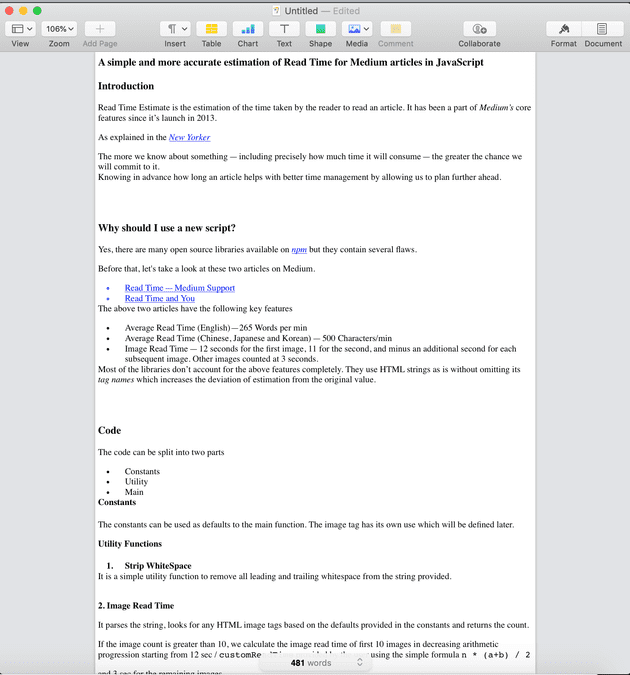Introduction
As explained in the New Yorker
The more we know about something — including precisely how much time it will consume — the greater the chance we will commit to it.
Knowing in advance how long an article helps with better time management by allowing us to plan further ahead.
Why should I use a new script?
Yes, there are many open source libraries available on npm but they contain several flaws.
Before that, let’s take a look at these two articles on Medium.
The above two articles have the following key features
- Average Read Time (English)—265 Words per min
- Average Read Time (Chinese, Japanese and Korean) — 500 Characters/min
- Image Read Time — 12 seconds for the first image, 11 for the second, and minus an additional second for each subsequent image. Other images counted at 3 seconds.
Most of the libraries don’t account for the above features completely. They use HTML strings as is without omitting its tag names which increases the deviation of estimation from the original value.
Code
The code can be split into two parts
- Constants
- Utility
- Main
Constants
The constants can be used as defaults to the main function. The image tag has its own use which will be defined later.
const WORDS_PER_MIN = 275; // wpm
const IMAGE_READ_TIME = 12; // in seconds
const CHINESE_KOREAN_READ_TIME = 500; // cpm
const IMAGE_TAGS = ['img', 'Image'];Utility Functions
Strip WhiteSpace
It is a simple utility function to remove all leading and trailing whitespace from the string provided.
function stripWhitespace(string) {
return string.replace(/^\s+/, '').replace(/\s+$/, '');
}Image Read Time
It parses the string, looks for any HTML image tags based on the defaults provided in the constants and returns the count.
If the image count is greater than 10, we calculate the image read time of first
10 images in decreasing arithmetic progression starting from 12 sec /
customReadTime provided by the user using the simple formula n * (a+b) / 2
and 3 sec for the remaining images.
function imageCount(imageTags, string) {
const combinedImageTags = imageTags.join('|');
const pattern = `<(${combinedImageTags})([\\w\\W]+?)[\\/]?>`;
const reg = new RegExp(pattern, 'g');
return (string.match(reg) || []).length;
}
function imageReadTime(customImageTime = IMAGE_READ_TIME, tags = IMAGE_TAGS, string) {
let seconds = 0;
const count = imageCount(tags, string);
if (count > 10) {
seconds = ((count / 2) * (customImageTime + 3)) + (count - 10) * 3; // n/2(a+b) + 3 sec/image
} else {
seconds = (count / 2) * (2 * customImageTime + (1 - count)); // n/2[2a+(n-1)d]
}
return {
time: seconds / 60,
count,
};
}Strip Tags
Next, we check for any HTML tags (both)in the string and remove it to extract only the words from it.
function stripTags(string) {
const pattern = '<\\w+(\\s+("[^"]*"|\\\'[^\\\']*\'|[^>])+)?>|<\\/\\w+>';
const reg = new RegExp(pattern, 'gi');
return string.replace(reg, '');
}Words Read Time
This utility function calculates the words count and Chinese / Korean and Japanese characters using the different Unicode character range.
The time is calculated by dividing it with the constants defined above.
function wordsCount(string) {
const pattern = '\\w+';
const reg = new RegExp(pattern, 'g');
return (string.match(reg) || []).length;
}
// Chinese / Japanese / Korean
function otherLanguageReadTime(string) {
const pattern = '[\u3040-\u30ff\u3400-\u4dbf\u4e00-\u9fff\uf900-\ufaff\uff66-\uff9f]';
const reg = new RegExp(pattern, 'g');
const count = (string.match(reg) || []).length;
const time = count / CHINESE_KOREAN_READ_TIME;
const formattedString = string.replace(reg, '');
return {
count,
time,
formattedString,
};
}
function wordsReadTime(string, wordsPerMin = WORDS_PER_MIN) {
const {
count: characterCount,
time: otherLanguageTime,
formattedString,
} = otherLanguageReadTime(string);
const wordCount = wordsCount(formattedString);
const wordTime = wordCount / wordsPerMin;
return {
characterCount,
otherLanguageTime,
wordTime,
wordCount,
};
}Humanize Time
Based on the distance of time in words, we can calculate and return the humanized duration of the time taken to read.
function humanizeTime(time) {
if (time < 0.5) {
return 'less than a minute';
} if (time >= 0.5 && time < 1.5) {
return '1 minute';
}
return `${Math.ceil(time)} minutes`;
}Main
The main function only consolidates all the utility methods in the correct order.
function readTime(
string,
customWordTime,
customImageTime,
chineseKoreanReadTime,
imageTags,
) {
const { time: imageTime, count: imageCount } = imageReadTime(customImageTime, imageTags, string);
const strippedString = stripTags(stripWhitespace(string));
const {
characterCount,
otherLanguageTime,
wordTime,
wordCount,
} = wordsReadTime(strippedString, customWordTime);
return {
humanizedDuration: humanizeTime(imageTime + wordTime),
duration: imageTime + wordTime,
totalWords: wordCount,
wordTime,
totalImages: imageCount,
imageTime,
otherLanguageTimeCharacters: characterCount,
otherLanguageTime,
};
}How much accurate is this script?
Taking the tests on the HTML string (from the chrome inspector) before this article section.
The tests and the Pages clearly give the correct estimate about the total words from the parsed HTML and the number of images.
Links
I’ve consolidated the complete code on GitHub. It is also available as an npm package read-time-estimate.

